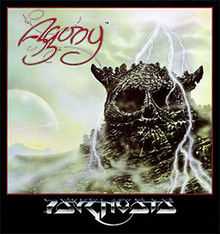Agony (video game)
| Agony | |
|---|---|
 Cover art by Roger Dean | |
| Developer(s) | Art & Magic[1] |
| Publisher(s) | Psygnosis[1] |
| Designer(s) | Yves Grolet[1] |
| Platform(s) | Amiga |
| Release date(s) | |
| Genre(s) | Shoot 'em up[1] |
| Mode(s) | Single player |
Agony is a side-scrolling shoot 'em up game, released by Psygnosis in 1992 for the Amiga platform.
Plot
Agony is a shoot 'em up but with a surreal-fantasy background. It features an owl (the company logo) flying its way through six worlds filled with monsters. The owl uses various waves of echo-location which the player fires at the enemies.
According to the manual backstory, the sun-wizard master Acanthropsis discovers the "Cosmic Power" with a toll on his life. Before dying he teaches it to his disciples, Alestes and Mentor.
Because of memory constraints, the game features no introduction,[2] however the game and manual mention that Alestes has been transformed into an owl, and has to pass through Mentor's traps and monsters in order to reach the Cosmic Power.
Technology
The game makes great use of many Amiga features such as scales of colors done with raster lines, halfbrite graphics mode for the between-level pictures, three layers of parallax scrolling using dual-playfield mode, in-game palette swapping and continuous flashing of the background palette to simulate additional colors. Featuring three floppies, the game ran on all Amiga computers. In common with other Amiga titles, the music was created with sampled sounds.
Music
The game featured a theme song by Tim Wright, which - atypically for an action game - was a classically-themed, piano-led instrumental. The title song was adapted without giving him proper credit by the keyboardist of Dimmu Borgir in the song "Sorgens Kammer" for their Stormblåst album.[3] The band did not know about this. Following several months of communication between Wright and Dimmu Borgir, and in a nod to the composer, the band did not include the track on a later re-recording of Stormblåst.[4]
The title song is also slightly different from the version that Tim Wright originally submitted to Art & Magic. Franck Sauer advised Wright that he could source improved piano sounds for the piece, and requested permission to change them. Wright agreed, but did not hear the end result before the game went to final master, and consequently some notes within the piece were transposed; this 'mistake' was also covered by Dimmu Borgir.[3]
Development Team
- Artwork: Frank Sauer, Marc Albinet[5]
- Programming: Yves Grolet
- In-game Music: Jeroen Tel
- Producer: Steven Riding
- Intro Music: Tim Wright, Martin Wall
- Intro Coding: Thomas Landspurg
- Ending Music: Robert Ling, Martin Wall
- Loadingscreen Music: Robert Ling, Martin Wall, Matthew Simons, Martin Iveson, Allister Brimble
- Flashback Compressor: Laurent Larminier
- Disk Loader: Mickael Janssens
- QA: Greg Duddle, Chris Stanley, Nick Burcombe
- Cover Art & Logo Design: Tony Roberts, Roger Dean
References
- ↑ 1.0 1.1 1.2 1.3 1.4 Agony release information at GameFAQs
- ↑ Agony trivia at MobyGames
- ↑ 3.0 3.1 Agony notes at Psygnosiss
- ↑ Re-recording information at Punk TV
- ↑ Sauer, Franck. "From fat pixels to tiny triangles". francksauer.com. Retrieved 2013-09-03.
External links
- Agony page from the game's artist Franck Sauer
- Agony at MobyGames
- Agony entry from Hall of Light
- Agony, game information & screenshots from UnExoticA
- Game Information, Files and Music at Psygnosis.org
- Agony screen setup and sprite-trick analysis from Codetapper